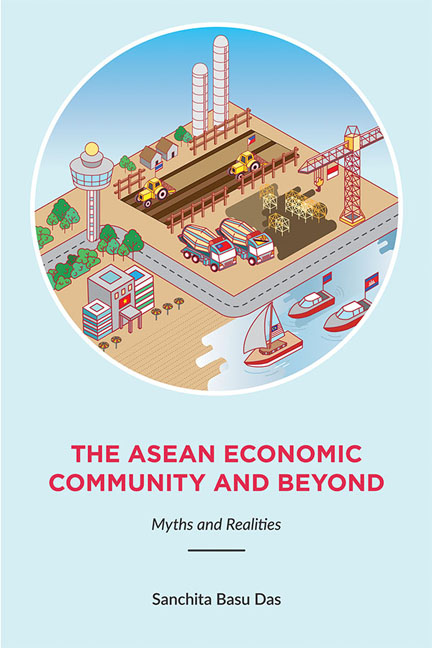Book contents
- Frontmatter
- Dedication
- Contents
- Foreword
- Acknowledgements
- Abbreviations
- 1 Introduction: The ASEAN Economic Community and Beyond
- I THE ASEAN ECONOMIC COMMUNITY (AEC)
- II BEYOND THE ASEAN ECONOMIC COMMUNITY
- III AN ASEAN PERSPECTIVE OF REGIONAL CONNECTIVITY
- 18 Promoting Asia's Infrastructure for Regional Trade and Investment
- 19 Addressing Infrastructure Financing in Asia
- 20 APEC and ASEAN Connectivity: Areas of Mutual Interest and Prospects of Cooperation
- 21 China's Three-pronged Strategy on Regional Connectivity
- 22 Can the China-led AIIB Support the ASEAN Connectivity Master Plan?
- Appendix: Summary of the Trans-pacific Partnership Agreement
- Index
- About the Author
18 - Promoting Asia's Infrastructure for Regional Trade and Investment
from III - AN ASEAN PERSPECTIVE OF REGIONAL CONNECTIVITY
Published online by Cambridge University Press: 19 May 2017
- Frontmatter
- Dedication
- Contents
- Foreword
- Acknowledgements
- Abbreviations
- 1 Introduction: The ASEAN Economic Community and Beyond
- I THE ASEAN ECONOMIC COMMUNITY (AEC)
- II BEYOND THE ASEAN ECONOMIC COMMUNITY
- III AN ASEAN PERSPECTIVE OF REGIONAL CONNECTIVITY
- 18 Promoting Asia's Infrastructure for Regional Trade and Investment
- 19 Addressing Infrastructure Financing in Asia
- 20 APEC and ASEAN Connectivity: Areas of Mutual Interest and Prospects of Cooperation
- 21 China's Three-pronged Strategy on Regional Connectivity
- 22 Can the China-led AIIB Support the ASEAN Connectivity Master Plan?
- Appendix: Summary of the Trans-pacific Partnership Agreement
- Index
- About the Author
Summary
Asia has been leading the world's economic growth for the past decade with the development of international production networks as one of its key strengths. For sustained growth, the production fragmentation process is profitable if the cost of transporting intermediate goods across borders is low in terms of time and money. This can be facilitated only with better infrastructure. However, most Asian countries suffer from infrastructure deficiencies. The region, in general, also remains below the world average in terms of quantity and quality of infrastructure. There exist wide gaps among the economies with regard to the trade facilitation and institutional processes. The 2010 Master Plan of ASEAN Connectivity has focused on infrastructure development, i.e. physical, institutional, and people-to-people connectivity; and similarly, APEC, under Indonesia's Chairmanship in 2013, has set connectivity as one of its priorities. How these organizations implement the connectivity projects will be keenly watched. This is important as (i) intra-regional economic activities in Asia and the Pacific are likely to increase with time, and (ii) ASEAN and APEC have substantial developmental differences among its member states which offer opportunities for expanding their production networks. ASEAN and APEC are looking for economic integration by 2015 and 2020 respectively, and this needs to be supported through the building of physical infrastructure, the promoting of trade facilitation and an increase in people-to-people interaction.
INTRODUCTION
The Asian Development Bank (ADB) in its April 2013 Economic Outlook reported that the Asia-Pacific, largely driven by the domestic factor, will continue with its strong economic growth of around 6.6 per cent in 2013 (ADB 2013) (vis-à-vis 6 per cent last year). ASEAN is expected to show a resilient growth of 5.4 per cent, while the two giant economies — China and India — are likely to grow by 8.2 and 6.0 per cent respectively. In contrast, the advanced economies (the United States, the EU and Japan) are forecasted to accelerate moderately by 1 per cent this year under conditions of uncertainty arising from fiscal tightening and period of consolidation.
Despite this positive economic projection for Asian economies, underinvestment in infrastructure, particularly in transport, energy and communication, remains a major concern.
- Type
- Chapter
- Information
- The ASEAN Economic Community and BeyondMyths and Realities, pp. 187 - 202Publisher: ISEAS–Yusof Ishak InstitutePrint publication year: 2015

